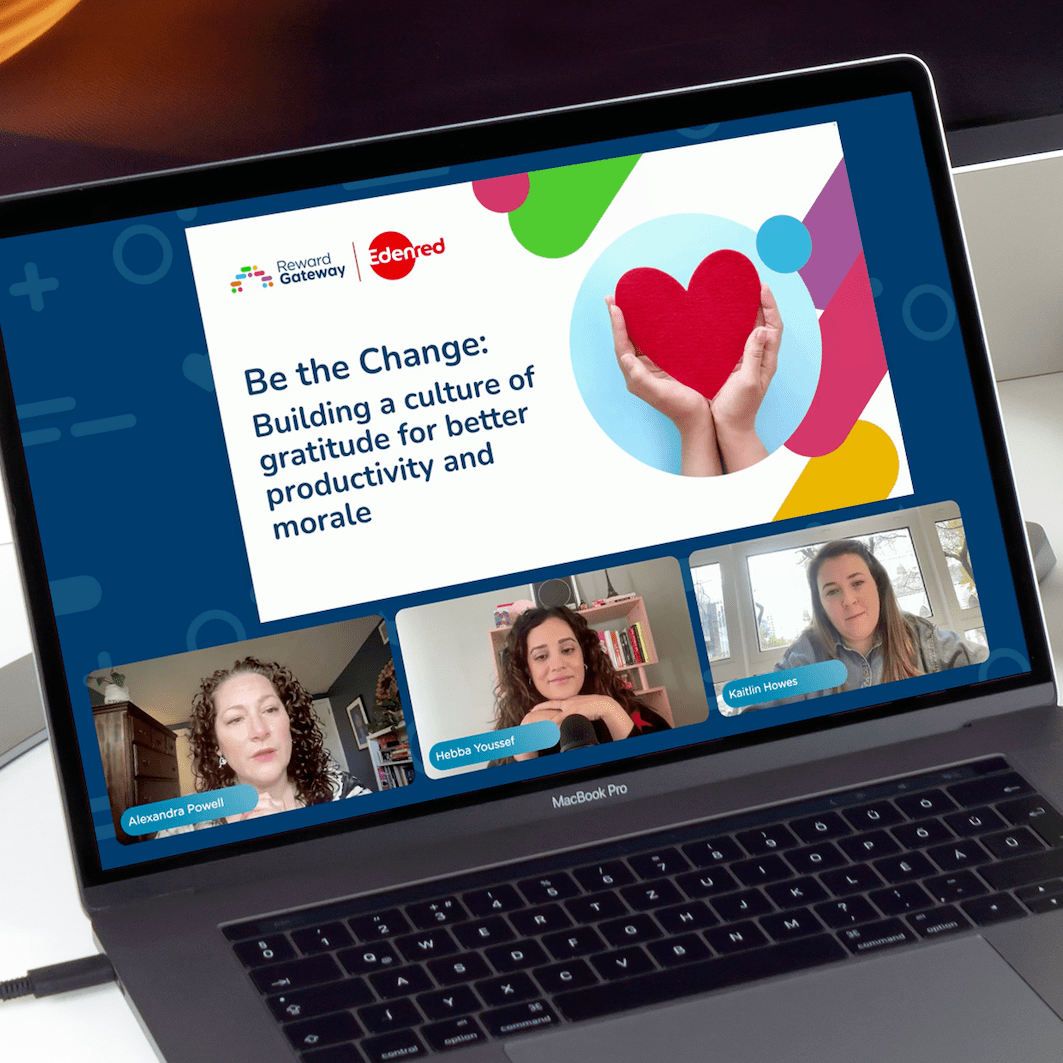Our most recent research shows that less than half (49%) of employees in the U.S. consistently feel appreciated at work. There are a lot of factors that contribute to a sense of appreciation at work, including recognition, autonomy, trust, feedback and relationships with colleagues and managers – and people who feel appreciated at work are more motivated and productive,
This month, we had the pleasure of hosting Hebba Youssef – Chief People Officer at Workweek, and founder of the popular podcast & newsletter, “I Hate it Here” – for a conversation with our very own Kaitlin Howes (HR Business Partner) and Alex Powell (Director of Client Cultural Insights) on building a culture of gratitude for better productivity and morale. You can watch the webinar here!
The webinar was chock full of insights on the state of HR today, building communities of trust and connection and firsthand accounts of the business value of gratitude in action. Today I want to highlight three of the points that resonated with me most:
Recognition vs. Appreciation - what’s the difference?
Before diving into creating a culture of gratitude, the team took some time to make a clarification: What’s the difference between ‘recognition’ and ‘appreciation?’ The terms are often used interchangeably, but there’s an important distinction:
“It's the difference between ‘who’ and ‘what’. Recognition is saying and showing thanks for what somebody is doing, while appreciation is really acknowledging somebody for who they are,” Kaitlin said.
This might seem like semantics – but appreciation and recognition play very different roles in creating a culture of gratitude.
 As Kaitlin noted, appreciation is about creating a sense of belonging and showing our people that we value them. I joined RGER shortly after graduating college in 2017, and my birthday came soon after. When I arrived in the morning, Kaitlin had taken the time to create an animation for our office welcome screen that incorporated photos of me, my love of sports, my nickname and the birthday I was celebrating. It was all about me – not my performance – and it went a long way in helping fresh-out-of-college me feel like I was part of a team.
As Kaitlin noted, appreciation is about creating a sense of belonging and showing our people that we value them. I joined RGER shortly after graduating college in 2017, and my birthday came soon after. When I arrived in the morning, Kaitlin had taken the time to create an animation for our office welcome screen that incorporated photos of me, my love of sports, my nickname and the birthday I was celebrating. It was all about me – not my performance – and it went a long way in helping fresh-out-of-college me feel like I was part of a team.
When appreciation is practiced effectively in tandem with action or behavior-focused recognition, the strategic impact can’t be overstated.
Gratitude as a Strategy
It’s easy to think of things like ‘gratitude’ and ‘appreciation’ as a bit… fluffy. Most leaders agree that saying ‘thank you’ to their people is the right thing to do – but with 40+ hours worth of to-do’s each week, in many cases, showing gratitude isn’t being prioritized.
According to Hebba however, this needs to change:
“I think we need to think of recognition and appreciation as an actual strategy. I wish more HR people reframed it that way to their leadership team. Like: ‘our strategy is that we are going to recognize and appreciate our employees, and here's why, and here's how.’ I don't want to make everything about being a business strategy - some things are about making people feel good, but I do think there's such an impact on the organization from productivity to engagement that it needs to be viewed as an actual strategy.”
When implemented correctly, recognition can be a modeling tool for the actions and behaviors that lead to better business outcomes. Alex tells a story of an HR leader she consulted with who was struggling to encourage employees to submit their expense reports on time – and as a result was spending too much time chasing folks to do so. However, after beginning to publicly recognize the folks who did submit their expenses on time, she found that others were more apt to follow suit and her time spent chasing reports decreased dramatically.
Make room for positivity in feedback
When most of us think of feedback, we think of ‘constructive criticism.’ However, when critical feedback is the only feedback, leaders miss out on the opportunity to build trust with their people and for their coaching to be accepted.
 Hebba mentioned: “Our human instinct is to be defensive. When you get any feedback, instantly your defenses are gonna go up. So I tell my managers all the time: If you want those defenses to come down, you have to build the trust and the capital with recognition and appreciation first.”
Hebba mentioned: “Our human instinct is to be defensive. When you get any feedback, instantly your defenses are gonna go up. So I tell my managers all the time: If you want those defenses to come down, you have to build the trust and the capital with recognition and appreciation first.”
While coaching comes naturally to many managers, this isn’t always the case with positive reinforcement or recognition. It can become a major obstacle to establishing trust. Alex recommends using a recognition framework – like our AVI method (Action, Value, Impact) that we use to take the guesswork out of giving effective, strategic recognition for managers. Hebba even suggested the benefits of using AI to aid in composing recognition messaging. Regardless of how it’s formulated, making space for positivity in your feedback mechanisms goes a long way in keeping folks feeling appreciated, even when receiving tougher feedback.
These insights are just the tip of the appreciation iceberg, so If you didn’t have the opportunity to join us live for the session – no worries! The webinar is available on-demand in our resource library (and here!), and you can get more thought leadership from Hebba at ‘I Hate it Here’!
If your organization has identified building a culture of appreciation, recognition and wellbeing as a priority, don’t hesitate to reach out to our team to learn more about our holistic Employee Experience Platform and how our clients across the globe are using it to build their own award-winning cultures.

 Michael Muldoon
Michael Muldoon



